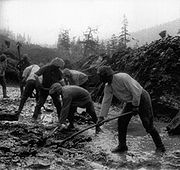
Sevvostlag
Encyclopedia

Dalstroy
Dalstroy , also known as Far North Construction Trust, was an organization set up in 1931 by the Soviet NKVD in order to manage road construction and the mining of gold in the Chukotka region of the Russian Far East, now known as Kolyma. Initially it was established as State Trust for Road and...
construction trust in the Kolyma
Kolyma
The Kolyma region is located in the far north-eastern area of Russia in what is commonly known as Siberia but is actually part of the Russian Far East. It is bounded by the East Siberian Sea and the Arctic Ocean in the north and the Sea of Okhotsk to the south...
region in April 1932. Organizationally being part of Dalstroy and under the management of the Labor and Defence Council of Sovnarkom, these camps were formally subordinated to OGPU later the NKVD
NKVD
The People's Commissariat for Internal Affairs was the public and secret police organization of the Soviet Union that directly executed the rule of power of the Soviets, including political repression, during the era of Joseph Stalin....
directorate of the Far Eastern Krai
Far Eastern Krai
Far Eastern Krai or Far Eastern Territory was an administrative subdivision of the Russian Soviet Socialist Republic during 1926-1938.The terms may also informally refer to Russian Far East.-History:...
. On March 4, 1938 Sevvostlag was resubordinated to the NKVD
NKVD
The People's Commissariat for Internal Affairs was the public and secret police organization of the Soviet Union that directly executed the rule of power of the Soviets, including political repression, during the era of Joseph Stalin....
GULAG
Gulag
The Gulag was the government agency that administered the main Soviet forced labor camp systems. While the camps housed a wide range of convicts, from petty criminals to political prisoners, large numbers were convicted by simplified procedures, such as NKVD troikas and other instruments of...
. In 1942 it was resubrdinated back to Dalstroy. In 1949 it was renamed to the Directorate of Dalstroy Corrective Labor Camps (Управление исправительно-трудовых лагерей Дальстроя). In 1953, after the death of Joseph Stalin
Joseph Stalin
Joseph Vissarionovich Stalin was the Premier of the Soviet Union from 6 May 1941 to 5 March 1953. He was among the Bolshevik revolutionaries who brought about the October Revolution and had held the position of first General Secretary of the Communist Party of the Soviet Union's Central Committee...
, with the reform of the Soviet penal system, it was again resubordinated to Gulag and later reformed into the Directorate of Far Eastern Corrective Labor Camps Управление Северо-восточных исправительно-трудовых лагерей, УСВИТЛ (USVITL).
The inmates served on all Dalstroy projects, the major ones being gold mining
Gold mining
Gold mining is the removal of gold from the ground. There are several techniques and processes by which gold may be extracted from the earth.-History:...
and road construction, including the infamous Kolyma Highway.
Structure and prisoners
Sevvostlag was the sole administration for the whole system of the forced labor of Dalstroy. The numerous labor camps usually mentioned for Kolyma and Dalstroy were formally referred to as subcamps ("camp subsivisions", лагерные подразделения) attached (but not subordinated) to the corresponding production units. Until the 1950s the only exceptions were camps on the periphery of Kolyma, which while servicing Dalstroy, were either detached from or attached to Sevostlag at various times.| Prisoners at the Sevvostlag | |||
|---|---|---|---|
| Year | Number | Year | Number |
| 1932 | 11,100 | 1943 | 99,843 |
| 1934 | 29,659 | 1944 | 76,388 |
| 1935 | 36,313 | 1945 | 87,335 |
| 1936 | 48,740 | 1946 | 69,389 |
| 1937 | 70,414 | 1947 | 79,613 |
| 1938 | 90,741 | 1948 | 106,893 |
| 1939 | 138,170 | 1949 | 108,685 |
| 1940 | 190,309 | 1950 | 131,317 |
| 1941 | 179,041 | 1951 | 157,001 |
| 1942 | 147,976 | 1952 | 170,557 |
| Figures for 1 January for each year. Figure for 1932 for December |
|||
From 1945-1949 there was a subcamp for Japanese prisoners of war in Magadan, which held 3,479 prisoners by January 1, 1949.
Notable inmates include the poet Osip Mandelshtam and Varlam Shalamov
Varlam Shalamov
Varlam Tikhonovich Shalamov , baptized as Varlaam, was a Russian writer, journalist, poet and Gulag survivor.-Early life:Varlam Shalamov was born in Vologda, Vologda Governorate, a Russian city with a rich culture famous for its wooden architecture, to a family of a hereditary Russian Orthodox...
, author of the Kolyma Tales.
Management and headquarters
The management was initially headquartered in the Srednikan settlement (now Ust-SrednekanUst-Srednekan
Ust-Srednekan is a village in Srednekansky District of Magadan Oblast, Russia....
, Magadan Oblast
Magadan Oblast
Magadan Oblast is a federal subject of Russia in the Far Eastern Federal District. Its administrative center is the city of Magadan....
). It was moved to the Nagayev Bay (Бухта Нагаева, now Magadan Oblast), and eventually to Magadan
Magadan
Magadan is a port town on the Sea of Okhotsk and gateway to the Kolyma region. It is the administrative center of Magadan Oblast , in the Russian Far East. Founded in 1929 on the site of an earlier settlement from the 1920s, it was granted the status of town in 1939...
.
Key individuals included:
- Rodion Vaskov (Родион И. Васьков) – (11.03.32 - 09.28.34)
- Ivan Filippov (Иван Г. Филиппов) – captain of state security (09.28.34 – 12.21.37)
- Stepan Garanin (Степан Н. Гаранин) – (12.21.37 – 09.27.38)
- A. Vishnevetsky (А.А. Вишневецкий) – captain of state security (02.16.40 – 02.19.41)
- Yevekl Drabkin (Евекль Иделевич Драбкин) – colonel of state security (05.19.41 – 03.13.45)
- N. Titov (Н.Ф. Титов) – Major General (03.13.45 – 07.27.48)
- A. Derevianko (А.А. Деревянко) – Major General (07.27.48 – 05.03.51)

